
Unlike some other organisations, there was relatively little furniture or equipment in a Foresters’ Court Room of any symbolic or ritualistic meaning. On the whole what was there had a practical purpose. So, for example, a Secretary’s desk met the real needs of providing a workplace with writing and storage area, whilst the Court box fulfilled its objective of being a robust, secure container for holding valuable documents and money.
Some might assign ritualistic values to items such as clubs or axes, and certainly these could be found in many Court rooms. It is, however, the discarding at an early period of many practices of the ‘secret orders’ that shows the desire of members of the Foresters’ to be open, practical, and modern in outlook.
What’s special about OUR furniture and equipment?
| > | All the items shown are genuine and original – nothing is a reproduction or facsimile |
| > | It can be placed in the context of member involvement with the activities of a Court |
Subject Headings Banners |
Further Reading None Known |
 |
 |
 |
 |
 |
 |
 |
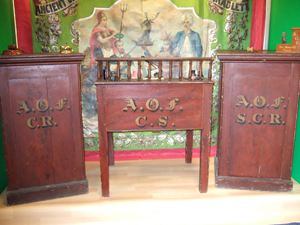 |
Court Furniture At the outset of the AOF in 1834, most Court (branch) meetings of members were held in rooms above or adjacent to public houses. The reason for this was there was no other suitable accommodation for the essentially private sessions to take place. With a beadle on the door, business could be transacted without fear of intrusion. In due course of time Foresters’ Halls appeared in some parts of the country, and with them a Court’s own suite of furniture. The Secretary’s desk was of prime importance, designed to hold all the relevant paraphernalia needed for Court meetings and to provide a suitable worktop for recording the Minutes of meetings. The Minutes of Court “Stone Ezel” of Leeds in January 1834, when still a Royal Order Court, recorded ‘that the Secretary’s desk be fitted up with a cupboard underneath to hold the Hats Caps &c. to open with 2 doors.’ For the Chief Ranger an imposing podium from which to direct the Court’s proceedings was appropriate and to acknowledge the role of the Sub Chief Ranger, a table provided. Drawing on the skills of its members, court furniture would be hand made. |
|
| Back to Top | ||
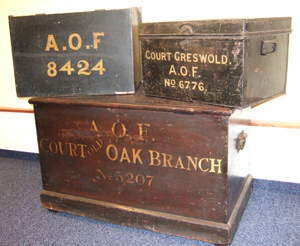 |
Court Box The security of Court valuables, including cash, was readily recognised by AOF members from the earliest years of the Order. Local friendly societies records show that the standard approach was to buy, or have made, a strong wooden box, with three separate locks and keys to be held by three different officers, this guaranteeing the need for all three to be present for a box to be opened. Members of the Royal Order Court “Stone Ezel” went further, agreeing at their meeting of 11th January 1834, held at the Brunswick Tavern, Camp Road, Leeds, to have two boxes, ‘the one to have 4 locks and the keys to be kept one by the PCR, one by the CR, one by the SCR, and one by the Secretary.’ The second box was to have just one lock and key, retained by the treasurer, and contain ‘the Money Checks (sic) Agreements &c. of the Court.’ As AOF Court “Stone Ezel”, No. 146, when deciding to deposit their cash with the Leeds Banking Company, members agreed ‘that Bros.Wm Kitson and Asquith order and get a tin box to be made with 3 locks to deposit the Banking Book and cheques. That Bros. Hepworth, Asquith and Ingle to hold the keys of the tin box.” |
|
| Back to Top | ||
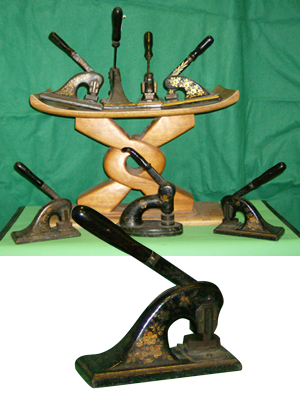 |
Seal Die Presses The authenticity of documentation issued by AOF Courts and Districts was of the utmost importance. To verify the genuine-ness, Districts and Courts were expected to have, initially, a seal, bearing specific details from which it could be ascertained that a document with a wax impression of its imprint was bona fide. In the 1840’s a Court seal cost 3s 9d (19p), and a District seal 4s 6d (22.5p). At that time each High Court Officer had his own seal, which was used when Dispensations were granted (see Certificates/Dispensations). Seals tended to be supplied by whoever the Executive Council was purchasing medals from. For example, in 1847 in the year ending July 1847, Bro. Thomas supplied 79 Court Seals and 12 District seals. Subsequently even the sealing wax could be bought from the EC, by the lb weight at 3s 0d (15p) per lb (0.45kg) in red, green or black. In 1861 the following announcement appeared in the London EC Quarterly Report. ‘As Courts and Districts may prefer having a Seal Die and Press for stamping upon paper, instead of the Brass Seal and Handle, thereby dispensing with the use of Wax, &c., the Council are prepared to supply the same to any Court or District sending an order. Die and Press complete, 15s.’ The eventual popularity of this cleaner method of stamping seems evident from the number of Dies and Presses in the Trust’s collection, examples of which are shown. Initially the suppliers were G P Tye, succeeded by J T Hellary of London. |
|
| Back to Top | ||
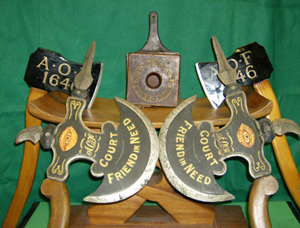 |
Axes Nothing exists in original AOF documentation to indicate where the idea of axes came from in connection with Courts, or when they first made an appearance. Walter Cooper (1984) connects them with both Court beadles and Woodwards although General Law at that date makes no reference to axes in relation to either post. Many Courts including the two represented here nevertheless adopted axes as items of Court regalia, often mounted in support stands and placed on the top table at Court meetings. Each has been made with evident care, probably by a Court member. One pair of axes comes from Court "Foresters Castle" No 1645, Southampton. The second pair belonged to Court "Friends in Need". |
|
| Back to Top | ||
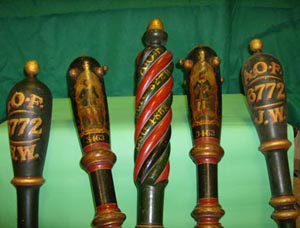 |
Clubs One of the practices continued in the Ancient Order of Foresters as a legacy from the Royal Order in 1834, was a combat or trial associated with an initiation ceremony. In this, by order of a new General Law of 1836, clubs (also called cudgels or quarter-staffs) replaced swords. The Foresters were amongst the first of the friendly society Orders to move away from rituals and secrecy linked to Freemasonry and this combat procedure was itself abolished in 1843, leaving clubs as a solely discretionary item of Court regalia. Traditionally they have become associated with the Beadles. In subsequent years a special form of folk-art appears to have developed in their manufacture with a wide variety of sizes and designs appearing.
|
|
| Back to Top | ||
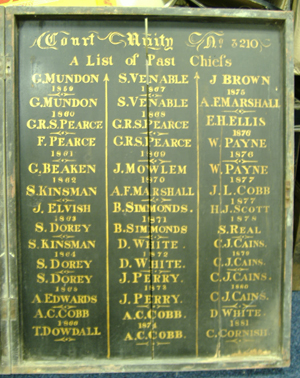 |
Honours Boards Seen in many AOF Court Rooms, the Honours Board of a Court generally listed the names and dates of office of members elected by their peers to serve as a Chief Ranger or Chairman, of a Court (branch). Almost without exception hand crafted, and often constructed to form panels which opened on either side of a framed and glazed Dispensation, they pay tribute to the efforts of many members whose services within their local community might otherwise be lost to history. The example of the honours board shown here illustrates the value of this item of court furniture. It shows the names of members serving as Chief Rangers of Court “Unity”, No. 3210 at Poole, in Dorset, from the date that it was instituted in 1859. An early PCR of this Court, Bro. G. R. S. Pearce, subsequently attained higher honours with the Order, being High Sub Chief Ranger on the Bournemouth Executive Council of 1888/89. |
|
| Back to Top | ||
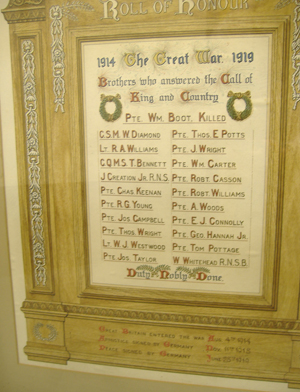 |
War Memorials As their way of commemorating those who gave their lives in the 1914-18 War, the Foresters instituted an AOF War Memorial Benevolent Fund, with the aim of supporting Widows and orphans. Over 150,000 Foresters had served in the armed forces, of who over 12,500 had been killed. Up and down the country local members, at District and Court level, subscribed to their own physical memorials and Rolls of Honour, some erected in a Court Room others in a public building. It is through reports of the many dedications of these that the scale of the impact on a Foresters’ Court, and a local community, becomes clear. Court “Unity” No 3663 at Newport Pagnell, Buckinghamshire, sent 290 members to the war - 47 who did not return were recorded on a Memorial unveiled at the Town Hall. ‘Over 300 answered their country’s call, out of which 40 made the supreme sacrifice’ from Court “Prosperity”, No.2469 at Holt, Suffolk. Their Memorial was unveiled at the Shire Hall. On the Roll of Honour, shown here, from Barrow-in-Furness, Lancashire, the names of members of Court “Schneider”, No. 5818 were recorded. Their names, their sacrifice, along with those of countless others, must never be forgotten. |
|
| Back to Top |